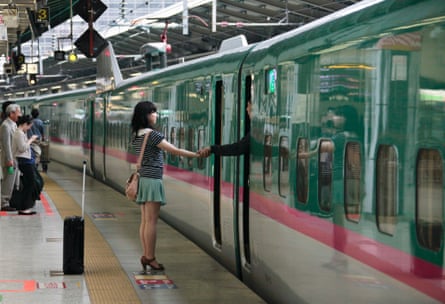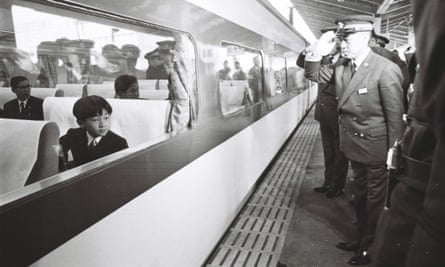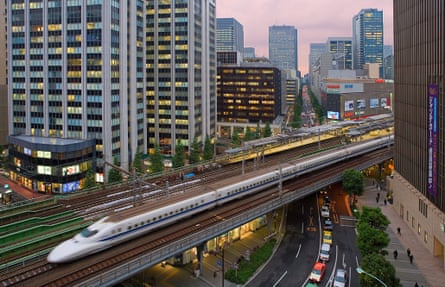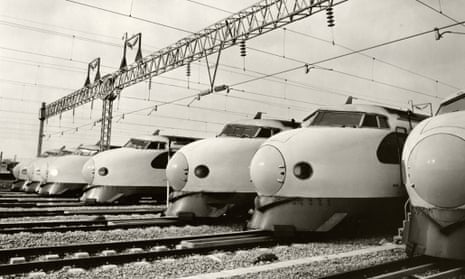At 10am on 1 October 1964, with less than a week and a half to go before the start of the Tokyo Olympic Games, the two inaugural Hikari Super Express Shinkansen, or “bullet trains,” arrived at their destinations, Tokyo and Osaka. They were precisely on time. Hundreds of people had waited overnight in each terminal to witness this historic event, which, like the Olympics, heralded not just Japan’s recovery from the destruction of the second world war, but the beginning of what would be Japan’s stratospheric rise as an economic superpower. The journey between Japan’s two biggest cities by train had previously taken close to seven hours. The Shinkansen had made the trip in four.
The world’s first high-speed commercial train line, which celebrates its 50th anniversary on Wednesday, was built along the Tokaido, one of the five routes that connected the Japanese hinterland to Edo, the city that in the mid-1800s became Tokyo. Though train lines crisscrossed the country, they were inadequate to postwar Japan’s newborn ambitions. The term “shinkansen” literally means “new trunk line”: symbolically, it lay at the very centre of the huge reconstruction effort. All previous railways were designed to serve regions. The purpose of the Tokaido Shinkansen, true to its name, was to bring people to the capital.

After the war Tokyo was in ruins, but its rebuilding progressed without any master plan. As industries gravitated to the city, young people flocked to Tokyo to work; and as they started families they were encouraged to buy homes. The only land they could afford, however, was outside the already densely populated city. Property prices skyrocketed in the 1970s, and even more during the “bubble era” of the 1980s, forcing newer families even further from the city centre. Tokyo swelled to elephantine proportions. The Greater Tokyo Metropolitan Area, composed of four prefectures, became the world’s pre-eminent megalopolis – some 35 million people by 2010, or 27% of Japan’s total population. It isn’t unusual for commuters to spend two hours getting to work every day on trains that exceed 150% of capacity.
This “rush hour hell” has been made famous worldwide by images of station employees stuffing stragglers into packed train cars – potent symbols of the superhuman forbearance of the Japanese worker, but also the dogged efficiency of Japan’s railways. All foreign visitors to Japan invariably ride the trains and come away with the same impression: Japan’s public transportation is the cleanest, most courteous in the world, run by uniformed, be-gloved men and women who still epitomise a hallowed Japanese work ethic that most companies struggle to maintain in an economy that has remained sluggish for two decades.

But the most vital aspect of this efficiency is that trains run on time, all the time. This is not just a point of pride. It is a necessity, given the huge number of people that have to be moved. Transfers are timed to the split second, and the slightest delay has the butterfly effect of delaying connections. The Shinkansen is no exception, as exemplified by the “angels”: teams of pink-attired women who descend on a train as soon as it arrives at its terminal and in five minutes leave it spotless for the return trip.
The first Shinkansen skirted the Pacific coast through the huge industrial corridor that links the capital with Osaka. This is a nearly unbroken stretch of urbanisation: it has few parallels on the planet. By the early 1950s the conventional train that ran on this route was crammed. Taking a hint from the private Odakyu Electric Railway, which launched a train that could reach speeds of 145km/hr, Japan National Railways (JNR) decided to develop an even faster train, and in April 1959 construction of the Tokaido Shinkansen commenced with an initial budget of ¥200bn (£1.1bn), though the eventual cost would be double that.
The high-speed network now reaches all the way west to the island of Kyushu and north to Akita, at the northern tip of the main island, Honshu. Next March, the Hokuriku Shinkansen will be extended to Kanazawa near the Japan Sea; there are plans to build a new line connecting Honshu to the northernmost island of Hokkaido. Each line is under the authority of one of four JR (Japan Railways) companies that formed when JNR was privatised in 1987. But the central government has overseen the construction of all new Shinkansen lines, usually covering 35% of the cost (JR companies pay 50% and local governments 15%). That means the construction ministry makes the relevant decisions about where lines go, or which cities get stations.
In an interview in the Tokyo Shimbun newspaper last week, Takashi Hara, a political scholar and expert on Japanese railroads, said the policy of extending the Shinkansen was promulgated by Kakuei Tanaka, Japan’s prime minister from 1972 to 1974. “The purpose was to connect regional areas to Tokyo,” Hara said. “And that led to the current situation of a national Shinkansen network, which completely changed the face of Japan. Travel times were shortened and vibration was alleviated, making it possible for more convenient business and pleasure trips, but I have to say that the project just made all the [connecting] cities part of Tokyo.”
And where the Shinkansen’s long tentacles go, other services shrivel. Local governments in Japan rely heavily on the central government for funds and public works – it’s how the central government keeps them in line. Politicians actively court high-speed railways since they believe they attract money, jobs and tourists. In the early 1990s, a new Shinkansen was built to connect Tokyo to Nagano, host of the 1998 Winter Olympics. The train ran along a similar route as the Shinetsu Honsen, one of the most romanticised railroads in Japan, beloved of train buffs the world over for its amazing scenery – but also considered redundant by operators JR East because, as with almost all rural train lines in Japan, it lost money. There were only two profitable stations on the line – Nagano and the resort community of Karuizawa – and both would be served by the new Shinkansen. A large portion of the Shinetsu Honsen closed down; local residents who relied on it had to use cars or buses.
Meanwhile, the bullet train has sucked the country’s workforce into Tokyo, rendering an increasingly huge part of the country little more than a bedroom community for the capital. One reason for this is a quirk of Japan’s famously paternalistic corporations: namely, employers pay their workers’ commuting costs. Tax authorities don’t consider it income if it’s less than ¥100,000 a month – so Shinkansen commutes of up to two hours don’t sound so bad. New housing subdivisions filled with Tokyo salarymen subsequently sprang up along the Nagano Shinkansen route and established Shinkansen lines, bringing more people from further away into the capital.

The Shinkansen’s focus on Tokyo, and the subsequent emphasis on profitability over service, has also accelerated flight from the countryside. It’s often easier to get from a regional capital to Tokyo than to the nearest neighbouring city. Except for sections of the Tohoku Shinkansen, which serves northeastern Japan, local train lines don’t always accommodate Shinkansen rolling stock, so there are often no direct transfer points between local lines and Shinkansen lines. The Tokaido Shinkansen alone now operates 323 trains a day, taking 140 million fares a year, dwarfing local lines. This has had a crucial effect on the physical shape of the city. As a result of this funnelling, Tokyo is becoming even denser and more vertical – not just upward, but downward. With more Shinkansen passengers coming into the capital, JR East has to dig ever deeper under Tokyo Station to create more platforms.
Deepest of all is the new Tokyo terminal for the latest incarnation of the bullet train – the maglev, or Chuo (“central”) Shinkansen, which is supposed to connect Tokyo to Nagoya by 2027 and is being built 40m underground. The maglev is the next technological stage in the evolution of high-speed rail travel. It is meant to be a morale booster for Japan’s railway industry, which no longer boasts the fastest trains or the biggest ridership in the world, distinctions that now belong to Japan’s huge neighbour to the west.

It is being built by JR Tokai, the company that runs the original super-profitable Tokaido Shinkansen, though experts assume the central government will eventually have to contribute money due to snowballing costs. The Chuo Shinkansen will cut the time it takes to get to Nagoya to 40 minutes, theoretically putting the central Japanese capital within commuting distance of Tokyo – in much the same way that the proposed HS2 will make Birmingham a bedroom community of London. “The Chuo Shinkansen will make Nagoya feel like a suburb of Tokyo,” said Hara.
If you have any doubt about that, consider that the maglev – short for “magnetic-levitation”, and known in Japanese as “linear motor car” – has to move in as straight and as level a line as possible in order to reach the speeds that will make it the fastest train on Earth. But since Japan’s topography is mostly mountainous, 86% of the journey will be underground. (The technology probably makes more sense on a flat, open terrain, and JR Tokai is trying to sell it abroad.) In other words, the maglev will essentially be a very long subway ride. Certainly few tourists will find it appealing.
Plans are to extend the maglev to Osaka by 2045, by which time potential ridership will have declined by a third, due to Japan’s shrinking population and more efficient air travel due to new regional airports. The Shinkansen is expensive; with the rise of low-cost carriers, any train trip that takes more than two hours from Tokyo is less cost-effective than flying. The development of the Shinkansen can’t be separated from geography. China’s faster, vaster high-speed rail service isn’t all focused on Beijing, because the country itself is huge; in Japan, however, until recently the Shinkansen was the best way to get to Tokyo from almost anywhere. Like the first Shinkansen, the maglev is a national project, even if the central government hasn’t spent any money on it (yet), but national priorities aren’t as clear as they were in the 1950s. Tokyo can’t get any bigger. Other areas of Japan are barely hanging on. Japan’s high-speed rail system may end up being the victim of its own success.

Comments (…)
Sign in or create your Guardian account to join the discussion